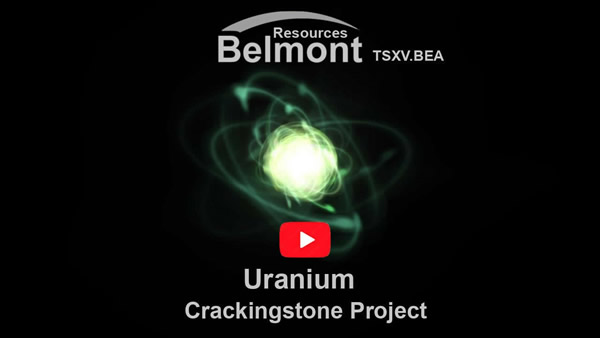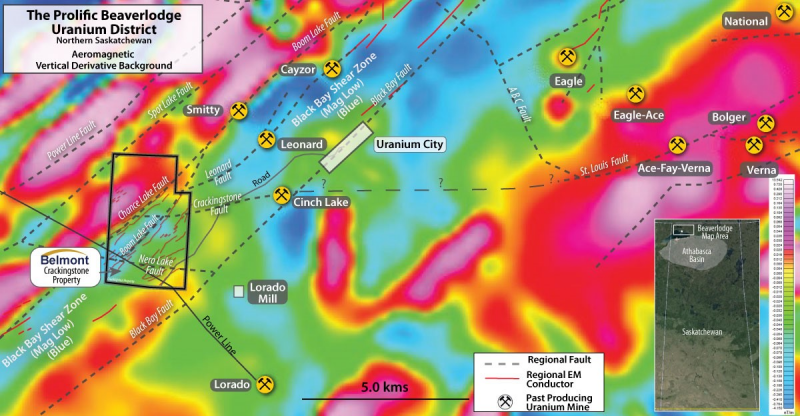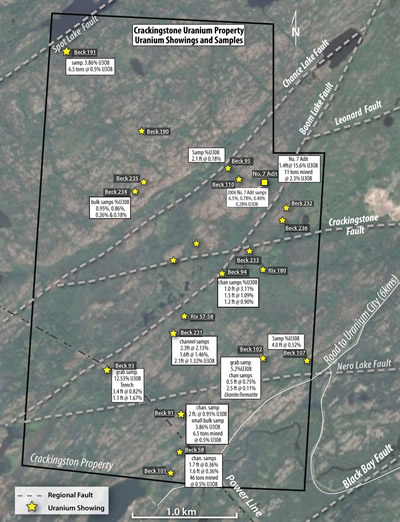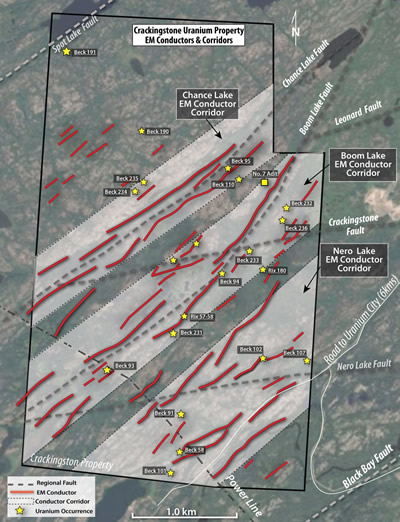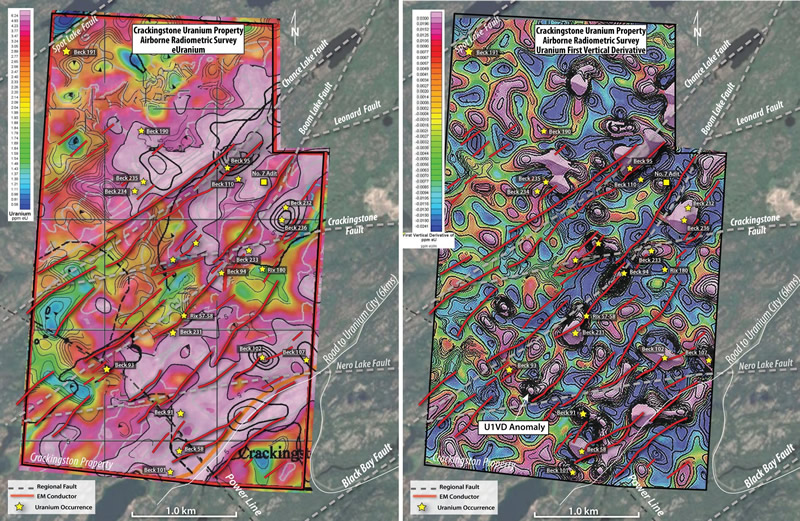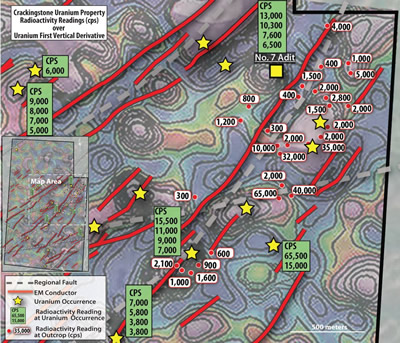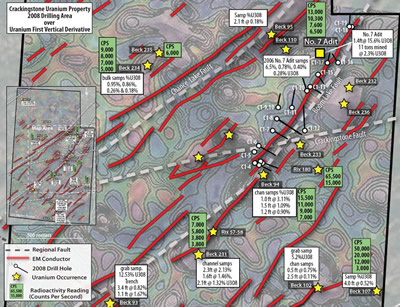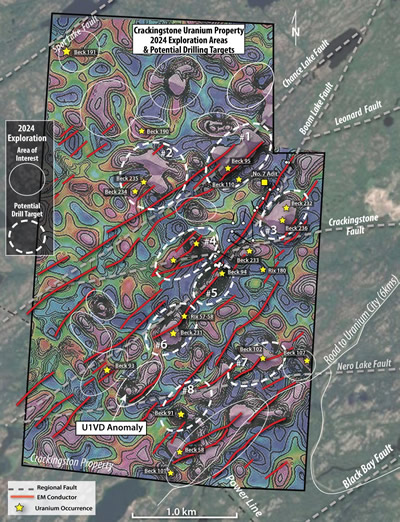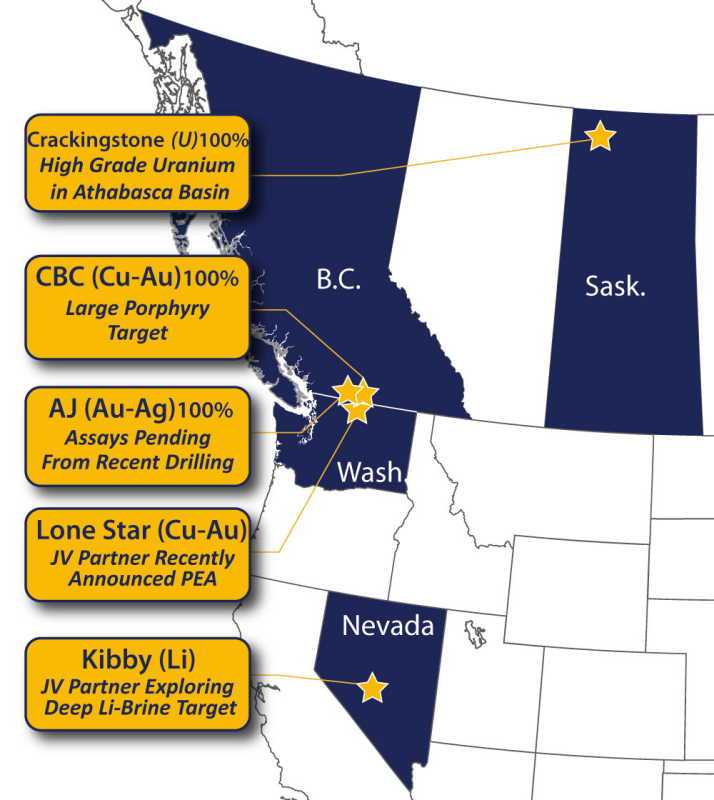Belmont Resources Announces 2024 Exploration Plans For Crackingstone Uranium Project, North Saskatchewan "Watch Feature Video"
(TheNewswire)
 | |||||||||
Crackingstone Highlights
-
Property cover 5kms of Black Bay Shear Zone which hosts several past producing uranium mines
-
Historic grab samples at uranium showings (%U3O8); Beck 93-12.53%; Beck 102-5.2% Beck 91 -2.86%
-
Belmont 2008 Drilling DH-C14 intercepted 2.09% U3O8 over 0.3 m and 0.87% U3O8 over 0.5 m within 1.18% U3O8 over 0.9 m from 49.1 to 50.0 m.
-
Ground Spectrometer surveying outlined a radioactive zone 1km long and 300m wide with CPS readings ranging from 400-65,000 cps.
-
No less than 3 major conductive structural corridors associated with Uranium occurrences identified totaling 10 kms, with 2 areas of fault intersections being prime locations for uranium mineralization
March 27, 2024 -Vancouver, B.C., Canada; Belmont Resources Ltd. (“Belmont” or the “Company”) (TSX.V: BEA; FSE: L3L2) is pleased to announce plans for a 2024 exploration and drilling program on its Crackingstone Uranium project situated in the Beaverlodge uranium district on the north shore of Lake Athabasca. This is the first time that Belmont is returning to the uranium project since its last successful 3,000 meter drill program in 2008. The project was put on hold after the drill program due to the 2008 market crash and a major drop in uranium prices.
George Sookochoff, President & CEO, Belmont Resources commented “We have been waiting for the right time to bring our Crackingstone Uranium project back on stream, and with uranium prices at an all-time high, now is certainly the right time to showcase Belmont’s great uranium project!”
We have produced a very informative video which does a great job in telling the Crackingstone visual story. We invite you to watch it at https://belmontresources.com/crackingstone-video/”
Beaverlodge Uranium District, North Shore of Lake Athabasca Saskatchewan.
The 100% owned Crackingstone property is located in the Beaverlodge uranium district, on the north shore of Lake Athabasca and only 6 km by road from Uranium City, Saskatchewan. A power line crosses the southern portion of the property.
Historic work in the Uranium City area dates back to the 1950’s. From 1953 to 1982, sixteen deposits were brought into production which produced a total of 70,250,000 lbs U3O8 averaging 0.24 % U3O8. The grades ranged from 0.18% to 0.43%.
The Crackingstone property covers 5 kms of the Black Bay Shear Zone, a major structural feature in the region which hosts several past producing mines such as the past producing Leonard and Smitty uranium mines combined to produce 876,000 lbs of uranium oxide and to the northeast the Cayzor uranium mine produced approximately 1,372,800 lbs with unexplored depth potential.
Crackingstone Historic Exploration
-
In 1958 Mr. E. Kull, drove a short adit which is now referred to as the Number 7 Adit, from the base of a trench, previously returned 15.6% U3O8 over 0.43m. He shipped 11 tons of broken rock to the Lorado mill which graded 2.3% U3O8.
-
In 1959 Uranium stain was visible at a few places near the Beck 91 showing. A channel sample assayed 0.61m at 0.95% U3O8 and a bulk sample from the same locality assayed 3.86% U3O8.
-
A grab sample containing considerable yellow stain, possibly fine disseminated pitchblende, from the Beck 93 showing, assayed 12.53% U3O8.
-
At the Beck 231 showing Channel sampling assayed 1.32% U3O8 over 0.64m, 2.13% over 0.70m and 1.46% over 0.49m.
-
At the Beck 102 showing a grab sample assayed 5.2% U3O8.
Structural Faults
On the property and on strike with the Black Bay structural corridor are the northeasterly Chance Lake and Boom Lake Faults. These two faults are on trend with the Leonard, Smitty and Cayzor past producing uranium mines, 6 kilometers north east of the property.
These faults appear to have been reactivated several times to provide ample fractured ground for hosting the uranium mineralization. The easterly Crackingstone fault intersects the two northeasterly faults on the property. The Cinch Lake uranium mine is situated on the Crackingstone fault 6 kilometers east of the property
The two areas of fault intersections are prime locations for potential uranium mineralization. The intersection area of the Boom Lake and Crackingstone faults tested successfully in a 20 hole drilling program in 2008.
A 2007 EM survey by Belmont has delineated three primary conductive corridors on the property. The Chance Lake and Boom Lake EM corridors are coincident with the Chance Lake and Boom Lake north easterly faults. The Nero Lake conductive corridor is a broad corridor trending north easterly in the south east area of the property. All three corridors are associated with Uranium occurrences.
Radiometric Survey
A 2007 Airborne Radiometric survey identified two large Uranium anomalies. The north anomaly is on a north easterly trend and appears to be associated with the northern portions of the Chance Lake and Boom Lake EM conductive corridors.
The south east Uranium anomaly trends north easterly as well, and appears to be associated with the Nero Lake conductive corridor.
The Uranium radiometric data was filtered to produce a “Uranium First Vertical Derivative (U1VD)” map. The U1VD algorithm enhances the shallow sources of uranium by suppressing the effect of the deeper ones. This helps to reveal near-surface uranium mineralization on the property. Most all of the uranium occurrences on the property are coincident with a U1VD anomaly which adds confidence to use of U1VD mapping as a powerful resource in combination with the structural faults and EM conductive corridors for the selection of future drill targets.
Ground Spectrometer Radioactivity Survey
A ground radioactivity survey using a RS-125 Spectrometer, over the central area of the property was conducted in 2007. Readings were taken in areas of rock outcroppings and also at various uranium occurrences. Several high radioactive readings were recorded in this area with readings reaching >65,000 CPS which is considered to be “off-scale”.
A radioactive zone 1km long and 300m wide, with CPS readings ranging from 400-65,000 CPS was identified on the north easterly trending Boom Lake conductive structural corridor.
2008 Drilling
In March of 2008 Belmont carried out a 20 hole, 3,000 meter diamond drilling program covering an 1,800 meter strike length from the Boom Lake – Crackingstone intersection north along the Boom lake fault.
All of the drill core was mineralized with uranium.
Some highlights are as follows:
Hole C14:
2.087% U3O8 over 0.3 m and 0.873% U3O8 over 0.5 m
within 1.182% U3O8 over 0.9 m from 49.1 to 50.0 m
Hole C8:
0.362% U3O8 over 0.15 m from 114.4 to 114.55 metres
within 0.277% U3O8 over 0.25 m from 114.4 to 114.65 m
0.371% U3O8 over 0.5 m starting from 116.2 to 116.7 m;
0.146% U3O8 over 0.35 metres from 123.35 to 123.7 m
Hole C10:
0.256% U3O8 over 0.4 m from 108.5 to 108.9 m
In addition to the uranium mineralization, drilling intercepted a 1.8 kilometer pegmatite dyke. Pegmatite is often associated with uranium mineralization in the Athabasca basin. Of equal importance was the extensive amount of hematite alteration intercepted across the entire 1.8 kilometer zone. Hematite alteration is commonly associated with uranium in the Athabasca basin. Hematite alteration is an indication of uranium precipitation during the hydrothermal event.
The results of the 2008 drilling were very positive with the interception of uranium mineralization, pegmatites and hematite alteration along the Boom Lake and Crackingstone structural fault zones confirming the methodology of exploring the intersection point of the structural features and the discovery of new zones of mineralization not previously known.
2024 Exploration
In preparation for a 2024 exploration program Belmont has compiled and modeled over 70 years of exploration survey data from the Crackingstone area. The newly compiled exploration database, with all available historical data, shows 21 areas with key characteristics for potential uranium mineralization. Of those 21 areas, 8 have been selected as high priority targets having all or most of the following criteria:
-
on or near a major fault,
-
on or near an EM conductor
-
on or near a U1VD anomaly,
-
surface uranium occurrence.
Phase 1 of the 2024 exploration program which is expected in Q2 of 2024, will involve ground verification of the high priority targets and prioritizing selected drill targets for a Q4 drill program.
About Belmont Resources
Belmont Resources has assembled a portfolio of highly prospective copper, gold, lithium, uranium and rare earths projects located in British Columbia, Saskatchewan, Washington and Nevada States. Its holdings include:
-
Athelstan-Jackpot (A-J): 2 former gold mines. Initial 2023 drill results from Athelstan gold mine area drilling indicates peripheral alteration zone to a potential deep-seated gold-copper porphyry.
-
CrackingstoneUranium: High grade uranium property situated in the prolific Beaverlodge Uranium District of the Athabasca basin. The Project covers 4 kilometers of the Black Bay Shear Zone, a northeast trending magnetic low corridor which hosts 4 past producing mines.
-
Come By Chance (CBC): 2021 geophysics delineated potential large copper-gold porphyry
2022 drilling provided further vectors towards potential core of porphyry;
-
The Lone StarCopper-Gold: optioned to Australian Marquee Resources ASX:MQR; MQR has spent $2.5M in drilling, completed new resource in Dec. 2022 and a PEA in November 2023 earning them a 50% interest in the property.
-
The Kibby Basin Lithium project located 60 kilometers north of the lithium rich Clayton Valley Basin: Optioned 80% of the central Kibby Playa claim block to Australian Marquee Resources MQR. MQR has spent $2.5M in drilling in 2022 for potential deep seated lithium brine. 2022 Drilling confirmed high levels of lithium-bearing sediments along with dissolved lithium in the groundwater. Mineralized intervals containing up to 924 ppm lithium with greater than 300 ppm lithium over thicknesses in excess of 450m have been identified in core samples of clay-rich playa sediments.
NI 43-101 Disclosure:
The technical and scientific information in this news release has been reviewed and approved by Laurence Sookochoff, P.Eng. Technical Advisor of the Company, who is a Qualified Person as defined by NI 43-101
ON BEHALF OF THE BOARD OF DIRECTORS
“George Sookochoff”
George Sookochoff, CEO/President
Neither the TSX Venture Exchange nor its Regulation Services Provider (as the term is defined in the policies of the TSX Venture Exchange) accepts responsibility for the adequacy or accuracy of this news release.
This Press Release may contain forward-looking statements that may involve a number of risks and uncertainties, based on assumptions and judgments of management regarding future events or results that may prove to be inaccurate as a result of exploration and other risk factors beyond its control. Actual events or results could differ materially from the Companies forward-looking statements and expectations. These risks and uncertainties include, among other things, that we may not be able to obtain regulatory approval; that we may not be able to raise funds required, that conditions to closing may not be fulfilled and we may not be able to organize and carry out an exploration program in 2023, and other risks associated with being a mineral exploration and development company. These forward-looking statements are made as of the date of this news release and, except as required by applicable laws, the Company assumes no obligation to update these forward-looking statements, or to update the reasons why actual results differed from those projected in the forward-looking statements.
Details on the sources of information contained within this News Release:
Report No. 126; Uranium Deposits of the Athabasca Region, Saskatchewan by L.S. Beck 1969, DEPARTMENT OF MINERAL RESOURCES, Geological Sciences Branch, Precambrian Geology Division.
A May 2008 Report On A Reconnaissance Sampling Program & Radon Gas Survey On the Crackingstone Property by J. Morgan, PhD Geologist & R.A. Bernatchez, B. Sc, P.Eng. Consulting Geologist.
A June 2009 Report On the Crackingstone Property 2008 Spring-Summer Diamond Drilling Program for Belmont Resources by J. Morgan, PhD Geologist & R.A. Bernatchez, B. Sc, P.Eng. Consulting Geologist.
An Interpretation of Aeroquest’s Airborne Geophysical Survey Magnetic and Electromagnetic Survey Job # 08-057 for Belmont Resources Magnetic and Electromagnetic Survey, April 16, 2009 by R.A. Bernatchez, P. Eng. Consulting Geologist.
Saskatchewan Mineral Deposit Index (SMDI) - digital information on all known mineral occurrences in the Province of Saskatchewan.
Copyright (c) 2024 TheNewswire - All rights reserved.
